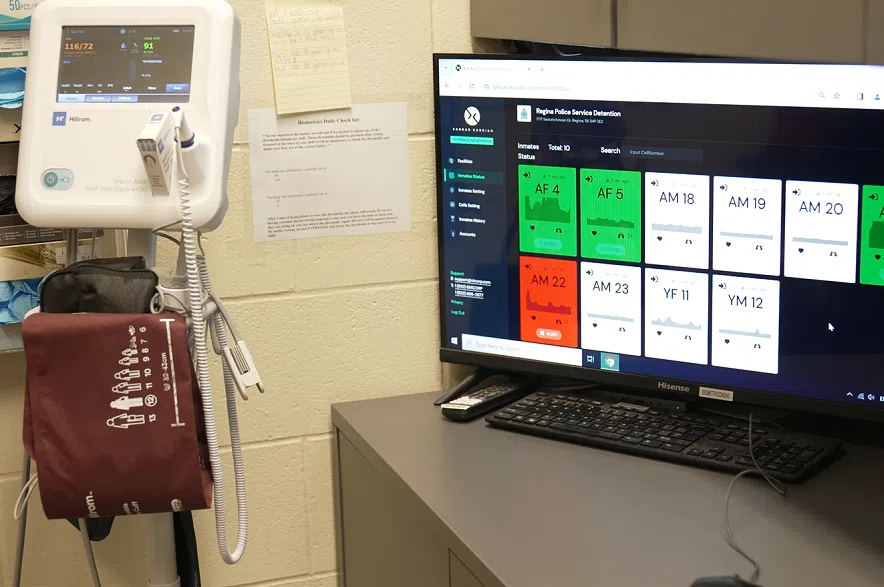For more than a month, police in Regina have been using a new system to closely monitor the health of detainees in cells.
The system, which was introduced in March, lets police view health data of prisoners in real-time, including heart rate and respiratory rate. Staff are automatically alerted to anomalies in the data, which the police service said allows them to respond more quickly to a health emergency.
The Regina Police Service is one of the first police forces in Canada to use the technology, which was adopted in the aftermath of the death of a prisoner last year.
“The decision to adopt biometric monitoring technology follows a comprehensive review of detainee care practices prompted by a tragic incident in August 2023, in which a male detainee’s death highlighted the critical need for enhanced monitoring capabilities,” the police service explained in a statement.

Paramedic Steve Brown says the system has been “wildly successful” since it was first installed in March. (Regina Police Service/Screenshot)
Staff Sergaent Pierre Beauchesne said the biometric system does not touch the inmate. It is attached to the ceiling and pulses into the room to record the inmate’s heart and respiratory rate.
Beauchesne said the system can monitor the inmate under a blanket or even under the mattress.
“There’s no health risk at all as they are lying there,” he said. “Their vitals are being assessed through the device.”
Ten of the cells have the biometric systems, one to each cell. Six radars are in male cells, two in female cells, one in a youth male cell, and one in a youth female cell.
Beauchesne said only certain people who are flagged by the police medical team go into a cell with a biometric radar. These could be people with pre-existing health concerns or a history or drug or alcohol use.
On March 22, Beauchesne said a respiratory alert went out only 15 minutes after a woman was taken into custody.
“Had that biometric alarm not gone off that female would likely be a decedent in our cells,” he said.
Beauchesne said staff gave life-saving CPR to the inmate. EMS took over care after they arrived.
Beauchesne said staff will continue to do 15 minute physical checks on inmates. Cells already have cameras in them, but Beauchesne said the radars help identify if the inmate is sleeping or having a medical emergency.
Data from the biometric system can only be accessed by the Regina Police Service. The biometric system will follow the same retention policies as Regina Police Service’s security video and audio. The radars data will not be retained indefinitely.
On the software, no personal identification of the inmate will be associated with the cell.
Beauchesne would not reveal the cost of the ten cells, but said the cost of a death inquest for an inmate in custody would cost “significantly more.”
He said death inquests typically cost between $80,000 and $100,000.
Regina police chief Farooq Sheikh said ensuring the safety of those in police custody is a top priority for the force.
“The introduction of biometric monitoring represents a proactive and innovative approach to detainee care, aligning with our commitment of leveraging technology to enhance public safety,” Sheikh said in a statement.
READ MORE:
- Regina police officer injured by friendly fire discharged from hospital
- Regina police plane temporarily out of commission
- Quality of service from Regina police up six per cent since 2021: Report
Steve Brown, a primary care paramedic, said the system has been “wildly successful” since it was implemented in March.
“We can detect respiratory arrests – so when someone stops breathing from fentanyl overdose – as well to the extent of a cardiac arrest, where someone’s heart stops,” Brown explained.
“Apart from being able to simply detect when it stops and starts, we’re able to detect rate, so we can see on a larger scale whether someone is trending upwards or downwards to be able to see if someone is getting considerably worse or better over time.”











